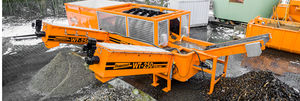
Belt feeder WB 620drumwetfor extruders

Add to favorites
Compare this product
Characteristics
- Type
- belt, drum
- Operating mode
- wet
- Product applications
- for extruders
- Other characteristics
- high-performance
Description
The input material is fed into the feeding hopper of the raccoon via wheel loader. The hopper doses it into the washing drum, where water is applied. The front part of the drum is closed to extend the interaction time between material and water. Due to the drum rotation friction between the individual particles of the input transfers the surface contamination into the water. In the rear the washing drum is perforated like a screen to drain the material of wash water. After drainage the washed product is discharged via the rear conveyor belt. In a washing process the input material is pre-screened at a grain size above the mesh width of the washing drum. This way just adhering surface contamination goes into the drum and through the screen into the water. If pre-screening below the mesh-size of the washing drum is carried out the Raccoon represents a wet classification process with the fine fraction in the water. In both cases, the water must be treated and solids removed to close the water loop using additional equipment. The oversize product is then clean of surface contaminations such as sludge, biofilm, sand etc.
Catalogs
No catalogs are available for this product.
See all of Doppstadt‘s catalogs*Prices are pre-tax. They exclude delivery charges and customs duties and do not include additional charges for installation or activation options. Prices are indicative only and may vary by country, with changes to the cost of raw materials and exchange rates.



